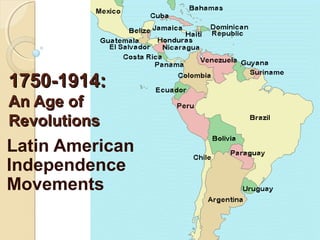
Latinamericanindependencemovementsandrevolutions 090319164612-phpapp02
- 1. 1750-1914: An Age of Revolutions Latin American Independence Movements
- 2. Background Indigenous peoples and civilizations ◦ Maya, Aztec, Inca European Colonization, 1500s ◦ Spain, Portugal, France American Revolution, 1776 French Revolution and Enlightenment, 1789 Napoleon’s conquests within Europe, 1800s
- 3. Latin American Independence Movements, 18th & 19th C.
- 4. François Toussaint- Simón Louverture- Miguel Hidalgo Bolívar Pedro I José de San Martín
- 5. French colonies: Revolution in Haiti Saint Domingue, now known as Haiti Western third of island of Hispanola in Caribbean Sea. Plantation slavery, sugar
- 6. Toussaint L’Ouverture Former slave, self-educated. Untrained in military and political matters, but became a skilled general and diplomat. Allegedly got name (“opening” in French) from being able to find openings in enemy lines. Took leadership of a slave revolt that broke out in 1791. 100,000 slaves in revolt.
- 7. By 1801, L’Ouverture moved into Spanish Santo Domingo (the eastern two-thirds of the island of Hispanola), took control of territory and freed slaves. In January 1802, French troops landed. Toussaint agreed to an end of fighting if the French would end slavery French accused him of planning another uprising. Sent him to a prison in the French Alps. He died 10 months later, April 1803.
- 9. Latin American social classes Peninsulares - men born in Spain ◦ held highest offices Creoles - Spaniards born in Latin America ◦ officers in army, but not in government ◦ often resented power of the peninsulares Mestizos - mixed European and Indian Mulattos - mixed European and African Indians/Africans
- 10. European Background: Napoleon Napoleon invaded Spain in 1808. Removed Spain’s King Ferdinand VII and made Joseph (Nap’s brother) king of Spain. Creoles used it as a reason for revolution. 1810 rebellion across Latin America. 1814, Napoleon defeated and Ferdinand returned to power, but creoles cont’d their movement.
- 11. Francisco Goya, Executions of May 3, 1808
- 12. Simon Bolivar Wealthy Venezuelan creole. “The Liberator”
- 13. Venezuelan Independence, 1821 Venezuela declared independence, 1811. Bolivar’s armies unsuccessful at first. 1819: Bolivar marched armies over Andes into today’s Colombia, defeated Spanish army. 1821: Venezuelan independence. Marched north to Ecuador to meet Jose de San Martin.
- 14. Jose de San Martin Simple, modest man. Born in Argentina, spent time in Spain as military officer.
- 15. Lima, Peru
- 16. Argentinean Independence Argentinadeclared independence in 1816. San Martin led army across Andes to Chile, joined by Bernardo O’Higgins, and freed Chile. Ecuador, 1822: San Martin met with Bolivar to decide how to remove remaining Spanish forces in Lima, Peru.
- 17. San Martin sailed for Europe and died on French soil in 1850. Dec9, 1824, Bolivar defeated Spanish at Battle of Ayacucho.
- 19. Gran Colombia, 1820-1830 Bolivar’s vision of a united South America. Present-day Colombia, Ecuador, Venezuela and Panama. Short-lived due to dissension amongst various factions. Bolivar resigned in 1828. In1830, Bolivar’s Gran Colombia divided into Colombia, Ecuador and Venezuela. Panama later split from Colombia with US assistance, 1903.
- 20. Mexico Indians and mestizos, not creoles, played the key role in independence movements. Creoles sided with Spain to avoid violence of lower-class rebellions (until 1820).
- 21. Miguel Hidalgo A village priest, believed in Enlightenment ideals. 1810, called for revolution. ◦ Grito de Dolores (call for revolution) Hidalgo’sIndian and mestizo followers marched to Mexico City. Spanish army and creoles acted against Hidalgo and defeated him in 1811.
- 22. Mexican Independence, 1821 1820 revolution in Spain put a liberal government in power. Mexican creoles feared loss of influence, so they united against Spain. Agustin Iturbide declared himself emperor, but was overthrown. 1824: Establishment of the Mexican Republic.
- 23. French Rule Conservative rebels plotted with France to reconquer Mexico. Napoleon III sent armies to Mexico. Cinco de Mayo, 1862: ◦ Zaragoza won the Battle of Puebla against the French, but the French won the war. Napoleon III appointed a relative, Austrian archduke Maximilian, as emperor of Mexico. Juarez resisted, US sent troops to Mexico - French gave up in 1867. Juarez continued reforms.
- 24. United Provinces of Central America Several other Central American states declared their independence from both Spain and Mexico to create the United Provinces of Central America.
- 25. Independence in South America 3 In South America, Native Americans had rebelled against Spanish rule as early as the 1700s, with limited results. It was not until the 1800s that discontent sparked a widespread drive for independence. Simon Bolívar, called “The Liberator,” :the George Washington of South America,” led an uprising that established a republic in Venezuela. He then captured Bogotá, Ecuador, Peru, and Bolivia. In 1816, José de San Martín helped Argentina win freedom from Spain. He then joined forces with Bolívar. Bolívar tried to unite the liberated lands into a single nation called Gran Columbia. However, bitter rivalries made that dream impossible. Before long, Gran Columbia split into three independent countries: Venezuela, Columbia, and Ecuador. (Panama)
- 26. By 1841, United Provinces of Central America had split into republics of El Salvador, Nicaragua, Costa Rica, Guatemala and Honduras. Conservative clergy and wealthy landowners resisted liberal, democratic reforms. Inability to agree to terms of a canal cost it much-needed revenue.
- 27. Period of Consolidation, 1825-1850 Breakdown of original nations and groups: ◦ Gran Colombia ◦ an original union between Bolivia and Peru ◦ United Provinces of Central America Instability of internal politics ◦ Bolivia experienced 60 revolts and coups. ◦ Venezuela experienced 52 revolts and coups Liberals - free trade, representative govt, federal government system Conservatives - protect church and upper classes ◦ controlled most regimes between 1830 and 1870. Independence movements and new governments run by Creoles Spanish administrators had excluded Creoles from political leadership, so few leaders could actually run a government.
- 28. Latin American Independence Movements, 18th & 19th C.
